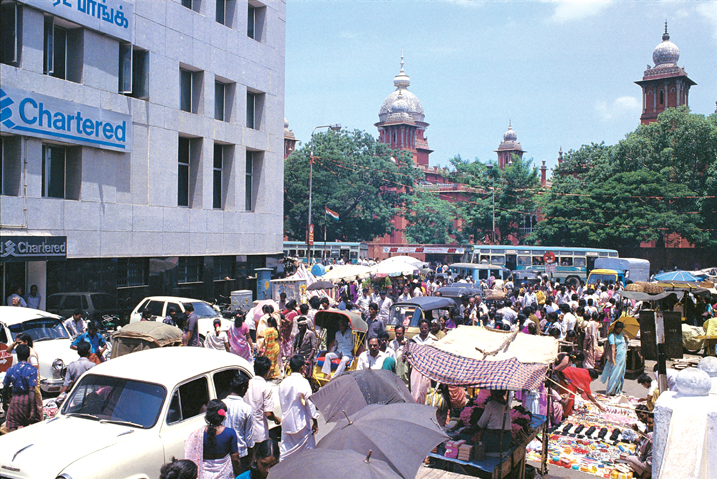
George Town today – chaos everywhere.
To meet the challenges posed by the core areas of aging cities like Mumbai, Kolkata and Chennai, planners have suggested two-prong approaches which include urban renewal and planned development of new towns in the periphery. These measures have to go hand-in-hand to achieve the desired results. Attempts are being made in Chennai to do this.
Chennai, the fourth largest metropolis in India, is of considerable economic importance. The foundation for Chennai, formerly known as Madras, was laid in 1639 by the English East India Company which constructed Fort St. George to expand its trade. Due to a lot of activity in and around the Fort and the development of the Port, Royapuram and the Railway, the growth around the Fort got accentuated.
To the north of the Fort, an area covering 5.5 sq. km – bound on the north by Old Jail Road, on the south by General Hospital Road, on the east by North Beach Road now known as Rajaji Salai, and on the west by Wall Tax Road, now VOC Road – is knit by narrow lanes and has become the home for numerous speciality markets such as cloth, gems, jewellery, other goods, banking, etc. Named after George, the Prince of Wales, George Town emerged as an area of high growth in trade, commerce and residential accommodation, leading to congestion.
Goerge Town, due to historic reasons, has many heritage buildings, public institutions and commerical establishments. Though much of the character of George Town remains intact in the nature and variety of its streetscape, many of the old buildings are a constant target of large-scale commercialisation. The streets and lanes form a maze.
To relieve congestion, steps were taken to remove the wholesale markets from George Town to Koyambedu which has been developed in an area of 296 acres to house the wholesale traders of perishable goods, foodgrains, textiles and other basic amenities. The perishable goods market (flowers, vegetables and fruits) is in an extent of 51 acres in Koyambedu. Meanwhile, the CMDA and Chennai Corporation are struggling to evict the wholesale flower traders from Badrian Street, George Town.
While the foodgrain merchants have agreed to move out from George Town to Koyambedu, the textile merchants have not shown the same willingness to move to Koyambedu. Meanwhile, the CMDA has had to hand over about 75 acres of land earmarked for the textile shops to Metro Rail for its depot and terminal facilities. Hence it is unlikely that the textile shops will move from George Town.
As part of the dispersal strategy, the inter-city and inter-state express bus terminuses functioning at Broadway were shifted to a new terminus at Koyambedu in 2002. However, George Town still experiences congestion, mainly due to the non-cooperation of traders and lack of public participation.
The CMDA, expressing its vision in the Second Master Plan to “make Chennai a prime metropolis which will become more livable, economically vibrant, environmentally sustainable and with better assets for the future generations”, speaks for George Town too. Taking stock of the situation arising out of the efforts made to decongest George Town, the following items need to be planned:
1. A suitable urban renewable policy for sustaining the jobs and economy of those who live in George Town.
2. Rehabilitation of the poor. This needs redevelopment of blighted areas in George Town.
3. Augment infrastructure in George Town.
4. Taking advantage of the high land value, attract the realtors to George Town for property development. The property owners in George Town will have to be persuaded to reconstitute their properties through joint ventures.
5. Efforts for conservation of heritage builidngs are needed.
6. Above all, public-private partnership for urban renewal programmes, both for infrastructure development and for housing, need to be undertaken.
Any city which denies/removes jobs and housing cannot thrive. (Courtesy: Our Building and Construction)
K.R. Thooyavan
|

